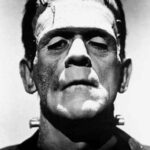Emotional isolation in Mary Shelley’s Frankenstein is the most significant and prevailing theme throughout the entire novel. This theme of loneliness originates from Shelley’s personal life and problems with her husband and father, which carry over into the novel and make it more realistic. During the time Shelley was writing Frankenstein, she was experiencing the emotional pangs of her newborn’s death and her half-sister’s suicide. These events undoubtedly affected the novel’s course and perhaps are a reflection of the person who was really lonely – Shelley herself. Referencing her past personal experiences in the characters of Robert Walton, the Creature, and Victor Frankenstein, Shelley takes her readers on a tumultuous journey that shows how loneliness can end in catastrophe.
Captain Robert Walton’s loneliness originates from being a failed poet who wants something great to happen to him. Walton’s loneliness is augmented by the letters he sends to his sister and it becomes clear that Walton is the first lonely person the novel introduces; “When, for example, Walton writes that (he has no friend), the categories of the literal and the figurative scarcely help us understand how he understands himself as friendless or recognize that he makes this statement in what can only be called an exchange of intimacy with his sister” (Yousef 221). Furthermore, Walton actually explains to his sister that he desires a friend to share his anticipated discoveries and disappointments with: “I shall commit my thoughts to paper, it is true; but that is a poor medium for the communication of feeling. I desire the company of a man who could sympathize with me, whose eyes would reply to mine. You may deem me romantic, my dear sister, but I bitterly feel the want of a friend” (Shelley 10). Writing and reading letters are much lonelier activities then telling a story in person. By employing an epistolary narrative writing style and by having Walton realize that letters or journals are not satisfying enough to communicate his emotions, Shelley increases the sense of loneliness in her novel.
Although both Walton and Frankenstein are social outcasts, in a twist of irony they become friends. After Frankenstein recognizes an image of himself in Walton, he shares his story with Walton but warns him: “You seek for knowledge and wisdom, as I once did; and I ardently hope that the gratification of your wishes may not be a serpent to sting you, as mine has been” (17). Giving this warning will be the best thing Frankenstein does in his entire life; instead of destroying life, Frankenstein now saves lives because his warning makes Walton realize he should not endanger his crew for his own merits like Frankenstein did with his family. To present this warning, Shelley seamlessly weaves the three main characters of the novel together as noted by Barbara Johnson: “All three autobiographies here are clearly attempts at persuasion rather than simple accounts of facts. They all depend on a presupposition of resemblance between teller and addressee” (Johnson 3). Among the three characters, there are indeed many resemblances which become clear by looking at Victor Frankenstein and the Creature.
The Artic, where Walton and Frankenstein meet, is one of the coldest, most desolate, and loneliest environments in the world; through this setting, Shelley symbolizes not only Walton’s but also Frankenstein’s loneliness. Another one of the many characteristics Walton and Frankenstein have in common is their scientific ambition. Frankenstein’s influence on Walton is paradoxical: one moment he urges Walton’s near-mutinous shipmates to stay courageous and not abandon their path, regardless of danger; the next – he serves as a wretched example of the dangers of selfish scientific ambition which is one of Shelley’s main intentions of the novel.
This scientific ambition Frankenstein shares with Walton is a result of Frankenstein’s history of rejection, emotional abandonment, and the resulting loneliness. Although Frankenstein tells Walton, “No youth could have passed more happily than mine. My parents were indulgent, and my companions amiable” (Shelley 20), this is more of a defensive and idealized introduction to his story. Psychologist Lee Zimmerman remarks: “Just as the monster is abandoned by Victor, so too Victor is abandoned-psychically and emotionally-by his ostensibly “doting” parents, who never acknowledge or strive to accommodate his inner world, and instead inflict their own version of reality on him” (Zimmerman 137). An example of Frankenstein’s parents inflicting their own version of reality on him is when Shelley writes how Frankenstein’s father “[…] looked carelessly at the title-page of [Victor’s] book, and said, “Ah! Cornelius Agrippa! My dear Victor, do not waste your time upon this; it is sad trash”” (Shelley 21). Furthermore, Frankenstein believes if his father would have told him why he rejected him reading Agrippa, things would have been different: “It is even possible, that the train of my ideas would never have received the fatal impulse that led to my ruin” (21). After Frankenstein’s mother dies and he leaves for Ingolstadt, Frankenstein reflects on his past: “I, who had ever been surrounded by amiable companions, continually engaged in endeavouring to bestow mutual pleasure, I was now alone” (26). Frankenstein continues to point out that although he has a family and a close friend who love him – he is a rather anti-social person: “I loved my brothers, Elizabeth, and Clerval, these were “old familiar faces;” but I believed myself totally unfitted for the company of strangers (26). Still Frankenstein does not realize the story he is telling, the Creature’s story of emotional abandonment, is in fact – his own story.
Once Frankenstein gets to Ingolstadt and continues Professor Waldman’s experiments, his obsession with creating life increases. Unfortunately “Victor seems unaware that in his fantasy he is dangerously overstepping “natural” bounds and becoming a pretender to god-like powers. His ambition is not dissimilar to a first-time pregnant women’s pride and grandiose hopes for her unborn child […]” (Waxman 19). However, a pregnant woman is natural whereas creating life from dead flesh and bones using electricity is not. Clerval, among others, disapproves of Frankenstein’s ideas which lead Frankenstein to seclude himself entirely from the outside world to focus on one thing – the creation of his own lifeform. Over time, Frankenstein becomes one of the loneliest characters in literature.
This becoming of a lonely character is exactly what happened in Shelley’s personal life. When she was seventeen, she ran off with Percy Bysshe Shelley, who was already married and abandoned his pregnant wife and his daughter to live with Shelley. Prior to getting married, they had two illegitimate children. To make matters worse, they married only a couple of weeks after Percy’s wife, Harriet, committed suicide. Shelley became a social outcast and had very few friends; “Within days she discovered that all of her old circle shunned her, intimates who had cherished her and friends who professed the most liberal principles” (Sunstein 88). At the end of the novel, Frankenstein finally finds a noble purpose in life in being a friend to Walton and warns him; “Frankenstein’s feelings of alienation and isolation are embedded in the context of attentions from father, friend, fiancée, and, finally, Walton, the stranger who comes to “love him like a brother”” (Yousef 223). Frankenstein himself is at fault for bringing loneliness upon himself and death to his family; however, the Creature is an exact opposite of Frankenstein in this aspect. The Creature’s unholy vengeance strips Frankenstein of everything he loves – this will ultimately make Frankenstein borderline crazy.
After its conception, much like Frankenstein himself, the Creature becomes lonelier and lonelier, spiraling downwards to sins, disaster, and death. For the Creature it is the constant rejection and its abandonment by Frankenstein at birth that lead it to loneliness and desperation: “In all probability, the creature was reaching out, as a small child does to their mother, but his ugly appearance only frightened Victor into running away” (Coulter). The initial feelings of abandonment after the Creature’s conception are described by Shelley: “It was dark when I awoke; I felt cold also, and half-frightened as it were instinctively, finding myself so desolate” (Shelley 68). The main reason for its rejection is the Creature’s grotesque features. The rejection by humans in general and specifically by its creator only fuels the Creature’s feelings of loneliness, emotional abandonment, and, as a result, anger.
There is, however, one particular catalyst to the Creature’s emotional deterioration: its rejection by the DeLacey family. When the Creature describe its need for companionship, Shelley’s own desire for a loving and attentive family is written between the lines: “The more I saw of them, the greater became my desire to claim their protection and kindness; my heart yearns to be known and loved by these amiable creatures: to see their sweet looks directed towards me with affection, was the utmost limit of my ambition” (89). The rejection the Creature receives from the DeLacey family is based on Shelley’s own betrayal and rejection by her father. Shelley’s mother died shortly after giving birth to her, and when her father first neglected his duties as a parent and later started a new family with Mary Jane Clairmont – he emotionally betrayed Shelley. Shelley represents this emotional desertion through Frankenstein’s decision to abandon and ignore his “son” the Creature. For the Creature, this rejection and desertion is the precipitating event to it seeking revenge against its creator. The Creature reflects on its loneliness: “Satan had his companions” (88), “I was alone. I remembered Adam’s supplication to his Creator; but where was mine? He had abandoned me, and, in the bitterness of my heart, I cursed him” (88), and “I am an outcast in the world for ever” (90). Despite the other lonesome characters in the novel, the Creature is really how Shelley sees herself minus the violent acts as far as history teaches us. The loneliness of the Creature leads it to unbelievable acts of violence, the first one being the killing of Frankenstein’s youngest brother William. The Creature describes its horrible sin in detail: “I gazed on my victim, and my heart swelled with exultation and hellish triumph: clapping my hands, I exclaimed, ‘I too can create desolation; my enemy is not impregnable; this death will carry despair to him, and a thousand other miseries shall torment and destroy him'” (97). Shelley is trying to teach the world a lesson by depicting that the Creature is not just a scientific project – the Creature is a living, emotional being.
Shelley shows how Frankenstein, much like her father, fails to fulfill the moral obligation of compassion and love towards his Creation. To satisfy its desire for a companion and while promising no more bloodshed, the Creature tells Frankenstein: “I am alone, and miserable; man will not associate with me; but one as deformed and horrible as myself would not deny herself to me. My companion must be of the same species, and have the same defects. This being you must create” (97). This desire for help and the ensuing rejection by Frankenstein can be reflected upon on Shelley’s life as she believed her father declined help to Percy Bysshe Shelley and herself when they needed support the most. Everything the Creature does or feels directly relates to its emotional seclusion. The effects of this terrible burden have progressively damaging results upon the Creature and indirectly cause it to act out its frustrations on the innocent friends or family of Frankenstein. The monster’s emotional isolation makes it gradually become angrier until evil fully prevails, and the lives of Frankenstein and the Creature end in catastrophe.
In choosing Captain Robert Walton as her outer frame, Shelley allows for the story to continue after Victor Frankenstein’s death and have Frankenstein’s story serve as a warning for Walton as well as Shelley’s readers. Even though Victor is the one who calls the Creature “wretched” (66), it is eventually Victor that becomes the “monster.” He is outcast, alone, and unloved – just as his “monster.” Ironically, “Victor’s reproaches echo those of the monster: ‘No one was near me who soothed me with the gentle voice of love; no dear hand supported me” (Zimmerman 145). This last quote by psychologist Zimmerman perfectly summarizes the demise of Victor Frankenstein with his emotional abandonment at its core. This lesson learned allows Frankenstein to warn a friend who is about to undergo the same emotional fate as Frankenstein. Furthermore, the character of the Creature shows that revenge does not alleviate the loneliness it feels. The creature acknowledges that it is unsatisfied in its revenge; through this admission – Shelley also concedes that her disdain for her father is pointless.
Works Cited
Coulter, Susan. Frankenstein – A Cautionary Tale of Bad Parenting.” Mary Shelley and Frankenstein. June 2001. Kim W. Britton. 27 March 2007 .
Johnson, Barbara. “My Monster/My Self.” Diacritics 12.2 (1982): 2-10. JSTOR Arts and Sciences. JSTOR. Kingwood Coll. Lib., Kingwood. 27 March 2007 .
Shelley, Mary. Frankenstein. 1818. Ed. Paul J. Hunter. New York: Norton, 1996.
Sunstein, Emily W. Romance and Reality. Johns Hopkins Paperbacks edition. Baltimore: The John Hopkins UP, 1991.
Waxman, Barbara Frey. “Victor Frankenstein’s Romantic Fate: The Tragedy of the Promethean Overreacher as Woman.” Papers on Language & Literature 23.1 (1987): 14-27. Academic Search Premiere. EBSCOhost. Kingwood Coll. Lib., Kingwood. 27 March 2007 .
Yousef, Nancy. “The Monster in a Dark Room: Frankenstein, Feminism, and Philosophy.” Modern Language Quarterly 63.2 (2002): 197-230. Project Muse. John Hopkins U. Kingwood Coll. Lib., Kingwood. 27 March 2007 http://muse.jhu.edu.
Zimmerman, Lee. “Frankenstein, Invisibility, and Nameless Dread.” American Imago 60.2 (2003): 135-158. Project Muse. John Hopkins U. Kingwood Coll. Lib., Kingwood. 27 March 2007 http://muse.jhu.edu.



